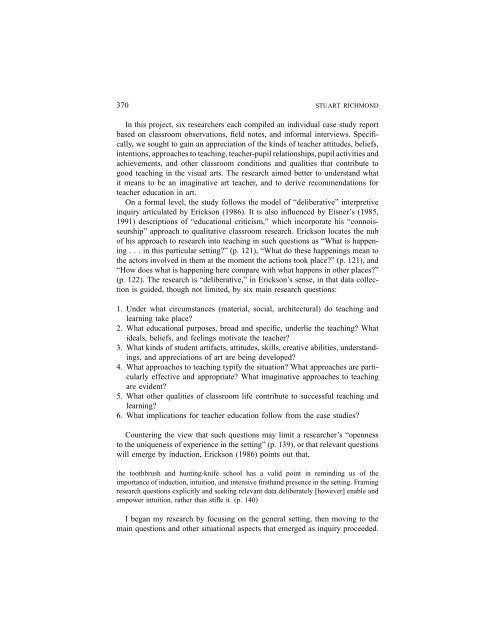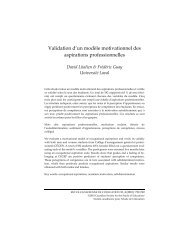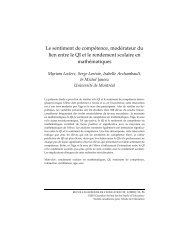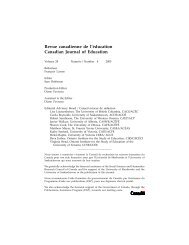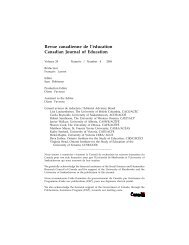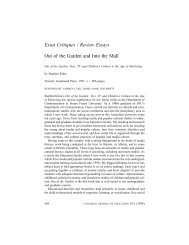Mireille Falardeau et Michel Loranger Le choix de stratégies ... - CSSE
Mireille Falardeau et Michel Loranger Le choix de stratégies ... - CSSE
Mireille Falardeau et Michel Loranger Le choix de stratégies ... - CSSE
Create successful ePaper yourself
Turn your PDF publications into a flip-book with our unique Google optimized e-Paper software.
370 STUART RICHMOND<br />
In this project, six researchers each compiled an individual case study report<br />
based on classroom observations, field notes, and informal interviews. Specifically,<br />
we sought to gain an appreciation of the kinds of teacher attitu<strong>de</strong>s, beliefs,<br />
intentions, approaches to teaching, teacher-pupil relationships, pupil activities and<br />
achievements, and other classroom conditions and qualities that contribute to<br />
good teaching in the visual arts. The research aimed b<strong>et</strong>ter to un<strong>de</strong>rstand what<br />
it means to be an imaginative art teacher, and to <strong>de</strong>rive recommendations for<br />
teacher education in art.<br />
On a formal level, the study follows the mo<strong>de</strong>l of “<strong>de</strong>liberative” interpr<strong>et</strong>ive<br />
inquiry articulated by Erickson (1986). It is also influenced by Eisner’s (1985,<br />
1991) <strong>de</strong>scriptions of “educational criticism,” which incorporate his “connoisseurship”<br />
approach to qualitative classroom research. Erickson locates the nub<br />
of his approach to research into teaching in such questions as “What is happening<br />
. . . in this particular s<strong>et</strong>ting?” (p. 121), “What do these happenings mean to<br />
the actors involved in them at the moment the actions took place?” (p. 121), and<br />
“How does what is happening here compare with what happens in other places?”<br />
(p. 122). The research is “<strong>de</strong>liberative,” in Erickson’s sense, in that data collection<br />
is gui<strong>de</strong>d, though not limited, by six main research questions:<br />
1. Un<strong>de</strong>r what circumstances (material, social, architectural) do teaching and<br />
learning take place?<br />
2. What educational purposes, broad and specific, un<strong>de</strong>rlie the teaching? What<br />
i<strong>de</strong>als, beliefs, and feelings motivate the teacher?<br />
3. What kinds of stu<strong>de</strong>nt artifacts, attitu<strong>de</strong>s, skills, creative abilities, un<strong>de</strong>rstandings,<br />
and appreciations of art are being <strong>de</strong>veloped?<br />
4. What approaches to teaching typify the situation? What approaches are particularly<br />
effective and appropriate? What imaginative approaches to teaching<br />
are evi<strong>de</strong>nt?<br />
5. What other qualities of classroom life contribute to successful teaching and<br />
learning?<br />
6. What implications for teacher education follow from the case studies?<br />
Countering the view that such questions may limit a researcher’s “openness<br />
to the uniqueness of experience in the s<strong>et</strong>ting” (p. 139), or that relevant questions<br />
will emerge by induction, Erickson (1986) points out that,<br />
the toothbrush and hunting-knife school has a valid point in reminding us of the<br />
importance of induction, intuition, and intensive firsthand presence in the s<strong>et</strong>ting. Framing<br />
research questions explicitly and seeking relevant data <strong>de</strong>liberately [however] enable and<br />
empower intuition, rather than stifle it. (p. 140)<br />
I began my research by focusing on the general s<strong>et</strong>ting, then moving to the<br />
main questions and other situational aspects that emerged as inquiry procee<strong>de</strong>d.


